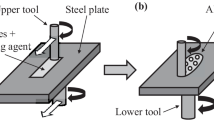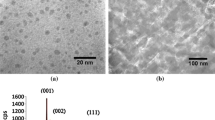Abstract
The foaming of an A1050 precursor was performed using only the frictional heat generated during the traversing of a friction stir processing (FSP) tool on a steel plate. In this study, the experimental conditions during FSP were optimized for relatively high melting point A1050 precursor. For tool traversing speeds of 10 mm/min and 20 mm/min, the A1050 precursor was successfully foamed, where the precursor gradually foamed during the traversing of the tool. However, too much heat was generated, which resulted in excess heat input, in the case of tool traversing speed of 10 mm/min, whereas there was less excess heat input in the case of tool traversing speed of 20 mm/min. Large pores were observed owing to the coalescence of pores, which may have induced the release of gas from the top surface of the Al foam during foaming, decreasing the porosity of the obtained Al foam. In the case of tool traversing speed of 30 mm/min, the latter half of the Al foam was sufficiently foamed and fine pores were observed, although the first half of the precursor was not foamed. Moreover, it was indicated that a uniform temperature distribution during FSP is necessary to obtain uniform pore structures, which may be achieved by gradually increasing the tool traversing speed. The use of a steel plate with lower thermal conductivity was effective for foaming the precursor, which may introduce too much heat into the precursor with less heat diffusion.











Similar content being viewed by others
References
Banhart J (2005) Aluminium foams for lighter vehicles. Int J Veh Des 37(2–3):114–125
García-Moreno F (2016) Commercial applications of metal foams: their properties and production. Materials 9(2):85
Banhart J (2013) Light-metal foams - history of innovation and technological challenges. Adv Eng Mater 15(3):82–111
Nandan R, DebRoy T, Bhadeshia H (2008) Recent advances in friction-stir welding - process, weldment structure and properties. Prog Mater Sci 53(6):980–1023
Utsunomiya T, Ishii N, Hangai Y, Koyama S, Kuwazuru O, Yoshikawa N (2012) Relationship between porosity and interface fracture on aluminum foam sandwich with dense steel face sheets fabricated by friction stir processing route. Mater Trans 53(9):1674–1679
Bonaccorsi L, Proverbio E, Raffaele N (2010) Effect of the interface bonding on the mechanical response of aluminium foam reinforced steel tubes. J Mater Sci 45(6):1514–1522
Hangai Y, Takada K, Endoh R, Koyama S, Utsunomiya T (2017) Foaming behavior of aluminum foam precursor induced by friction heat generated by rotating tool used for spot friction stir welding. J Manuf Process 25:426–431
Hangai Y, Takada K, Fujii H, Aoki Y, Utsunomiya T (2019) Foaming behavior of blowing- and stabilization-agent-free aluminum foam precursor during spot friction stir welding. J Mater Process Technol 265:185–190
Hangai Y, Takada K, Endo R, Fujii H, Aoki Y, Utsunomiya T (2018) Foaming of aluminum foam precursor during friction stir welding. J Mater Process Technol 259:109–115
Hangai Y, Utsunomiya T, Hasegawa M (2010) Effect of tool rotating rate on foaming properties of porous aluminum fabricated by using friction stir processing. J Mater Process Technol 210(2):288–292
Sato YS, Park SHC, Matsunaga A, Honda A, Kokawa H (2005) Novel production for highly formable Mg alloy plate. J Mater Sci 40(3):637–642
Su JQ, Nelson TW, Sterling CJ (2005) Friction stir processing of large-area bulk UFG aluminum alloys. Scr Mater 52(2):135–140
Hangai Y, Amagai K, Omachi K, Tsurumi N, Utsunomiya T, Yoshikawa N (2018) Forming of aluminum foam using steel mesh as die during foaming of precursor by optical heating. Opt Laser Technol 108:496–501
Light-Metal-Association (1996) The handbook of advanced aluminum technology. KALLOS PUBLISHING CO., LTD., Tokyo
Maeno T, K-i M, Unou C (2012) Hot metal gas forming process for aluminium alloy tube using sealing pressure and resistance heating. J Japan Soc Technol Plast 53(612):54–58
Acknowledgments
This work was partly performed under the Cooperative Research Program of Institute for Joining and Welding Research Institute, Osaka University. This work was financially supported partly by the Light Metal Education Foundation, Inc.
Author information
Authors and Affiliations
Corresponding author
Additional information
Publisher’s note
Springer Nature remains neutral with regard to jurisdictional claims in published maps and institutional affiliations.
Rights and permissions
About this article
Cite this article
Hangai, Y., Takada, K., Fujii, H. et al. Foaming of A1050 aluminum precursor by generated frictional heat during friction stir processing of steel plate. Int J Adv Manuf Technol 106, 3131–3137 (2020). https://doi.org/10.1007/s00170-019-04834-4
Received:
Accepted:
Published:
Issue Date:
DOI: https://doi.org/10.1007/s00170-019-04834-4




